Our Drainage System Services in Portland
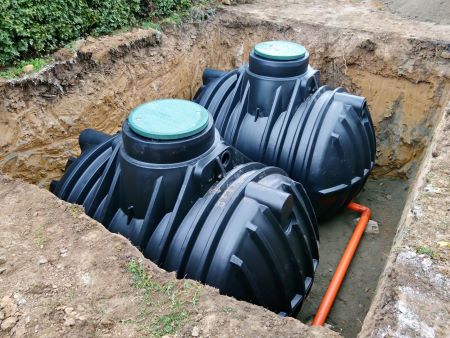 Superior Underground is an expert in drainage systems and achieving maximum water flow. We handle all types of residential and commercial property systems, including catch basins, dry wells, sewer lines, french drains, and grease interceptors. We also specialize in StormTech Chamber installs for your stormwater storage needs. For over 15 years, we have been Portland’s experts in drainage system services and main water line repairs.
Superior Underground is an expert in drainage systems and achieving maximum water flow. We handle all types of residential and commercial property systems, including catch basins, dry wells, sewer lines, french drains, and grease interceptors. We also specialize in StormTech Chamber installs for your stormwater storage needs. For over 15 years, we have been Portland’s experts in drainage system services and main water line repairs.
There are many different types of modern drainage systems available, and the best system for your home will depend on several factors. Each system has its own benefits and drawbacks, so it’s important to consult with an expert before making a final decision. Call us for all of your excavation needs!
Our French Drain System Is the Best
French drains are trench drains that provide a smooth channel for water to flow through. Water runs into a gravel-filled trench, then into a perforated pipe at the bottom of the trench. Water travels freely through the pipe, which empties a safe distance from the house. French drains are installed around a property’s perimeter and help redirect water away from the house foundation. This can prevent flooding and water damage in the event of a heavy rainstorm.
The system consists of trenches filled with gravel or other drainage materials. A pipe is then placed at the bottom of the trench, and the entire system is covered with soil. French drain systems are most commonly used to prevent water from pooling around foundations or in basements, but they can also be used to drain agricultural fields or drainage golf courses. A french drain is an effective way to prevent water damage and is relatively easy to install.
Try Our Stormwater Management Systems by StormTech
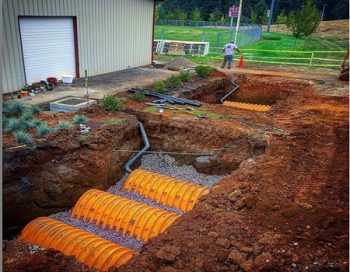
StormTech provides unsurpassed engineering value among underground detention systems. Cost savings and longer life expediencies are just some of the benefits of using StormTech chambers. Chamber systems get assembled 30-50% quicker, easier, and with less machine time.
Storm chambers capture rainwater runoff from roofs and gutters and divert it safely into storm sewers. This helps reduce flooding during heavy rains, which also mitigates erosion. Once the storm has passed, the excess water is slowly released from the chambers, preventing sudden water surges from entering drainage systems and causing flooding. Storm chamber systems can be an effective way to reduce the risk of flooding. Basin management is needed to make sure these systems work properly.
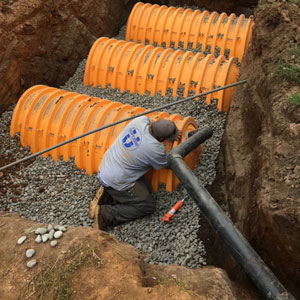
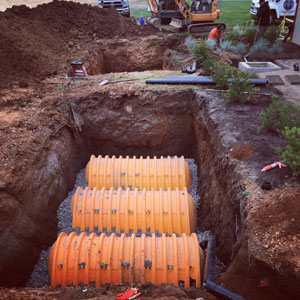
We Offer Catch Basin Inlets for Your Storm Drain System
A catch basin is an inlet to the storm sewer system that typically includes a grate or curb inlet where stormwater enters the catch basin and a sump pump to capture sediment, debris, and associated pollutants. They are also used in combined sewer watersheds to capture floatables and settle some solids. Catch basins act as pre-treatment for other treatment practices by capturing large sediments.
A catch basin is a structure that is used to collect sediment and other debris when stormwater flows into the road. Catch basins are typically installed at the low point of a drainage system, where they can intercept runoff before it has a chance to cause erosion or sedimentation. In addition to sediment, retention basins can trap leaves, twigs, and other organic matter. This material can then be removed from the catch basin and composted or disposed of in another way.
Find Your Next Dry Well System With Us
Dry wells are often used in areas where the soil can’t absorb excess water quickly enough, such as on slopes or near foundations. By collecting and redirecting water away from these areas after intense rainfall, dry wells can help to prevent water damage and erosion. In particular, they benefit basement walls, protecting them from water damage. Depending on the soil characteristics in your area, you might consider this option.
A dry well receives water from one or more entry pipes or channels at its top. It discharges the excess water through several small exit openings distributed over a larger surface area on the sides and bottom of the dry well. This ensures that excess water doesn’t discharge into drainage systems too quickly.
A dry well drainage system is an efficient way to manage water drainage on your property. These systems are designed to collect and store water runoff from rainfall or other sources and then slowly release it into the ground. This helps prevent flooding and soil erosion and reduce the risk of foundation damage. Dry wells help prevent flooding in your yard and can generally get installed within a day!
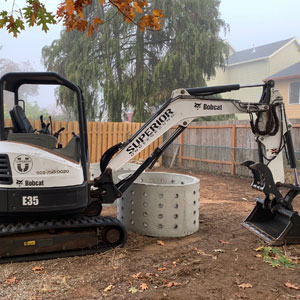
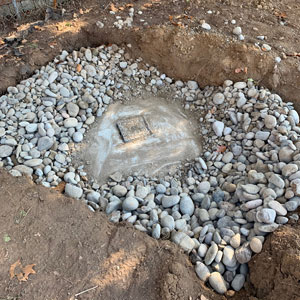
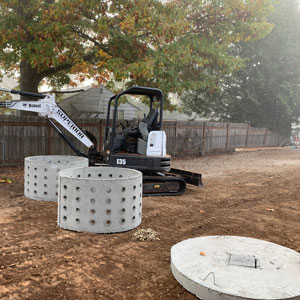
We Have Grease Trap Systems
A grease interceptor, or grease trap, holds or traps the grease from going into the main sewage line. A large tank is placed underground near the foundation of the building. Drainage lines from the kitchen get directed into the grease trap before exiting into the main sewer line. Grease traps are like a septic tank and, once full, will need to be pumped out occasionally and maintained to ensure proper flow.
Grease interceptors are designed to trap grease and oil from kitchen sinks, dishwashers, and garbage disposals. They prevent grease buildup in sewer pipes, which is especially important for restaurants. Grease clogs can be especially hard to get rid of, so definitely consider installing a grease interceptor if you do a lot of cooking!
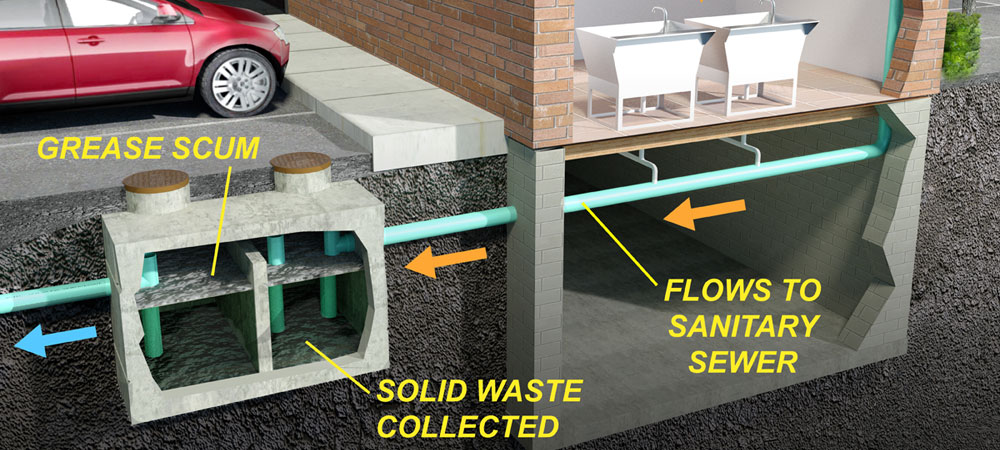
Your Local Drainage Pipe Experts!
When you need services related to advanced drainage systems in Southwest Washington and the Portland metropolitan area, give Superior Underground a call! Whether you need a new drainage system for your home or your business, our team of professionals can get you set up with a drainage system that works for you!
FAQs About Drainage Systems
Surface Drainage: This type of drainage system focuses on directing excess water on the surface away from a particular area. It includes techniques like grading, slope creation, and construction of swales or ditches to channel water.
French Drains: A French drain is a type of subsurface drainage system that consists of a perforated pipe surrounded by gravel or rock. It helps to redirect water away from foundations, basements, or low-lying areas.
Stormwater Drainage: This drainage system manages rainwater runoff from roofs, roads, and other impervious surfaces to prevent flooding and erosion. It includes gutters, downspouts, and stormwater management facilities.
The efficiency of a drainage system depends on the specific context and requirements of the project. There is no one-size-fits-all answer to the most efficient drainage system, as different systems excel in different situations. However, in many cases, a well-designed combination of surface and subsurface drainage is often considered efficient. For example, a system that utilizes well-designed gutters, downspouts, and swales to manage surface runoff, coupled with strategically placed subsurface drains or French drains to handle groundwater, can be highly effective.
The key to efficiency lies in thorough planning, proper design, and the implementation of appropriate drainage techniques based on the site’s characteristics and local climate conditions.
Designing a drainage system requires careful consideration of several factors to ensure its effectiveness:
- Conduct a thorough assessment of the site’s topography, soil composition, and existing drainage patterns to identify problem areas and determine the best approach.
- Determine the sources of excess water, such as rainfall, underground springs, or runoff from nearby areas.
- Plan the flow paths to direct water away from structures and low-lying areas, aiming to discharge it safely into natural drainage channels or designated outlets.
- Based on the site evaluation, select the appropriate combination of surface and subsurface drainage techniques, such as swales, gutters, downspouts, French drains, or catch basins.
- Properly size the drainage elements and ensure adequate slope for water to flow effectively.
- Use suitable materials for drainage pipes, including corrosion-resistant and durable options.
- Carefully install the drainage system components, ensuring proper connections, slopes, and secure placement.
- Develop a maintenance plan to regularly inspect and clean the drainage system to prevent clogs and blockages.
By following these steps and working with a qualified professional if needed, you can create an effective drainage system that efficiently manages water and reduces the risk of flooding or water damage.
